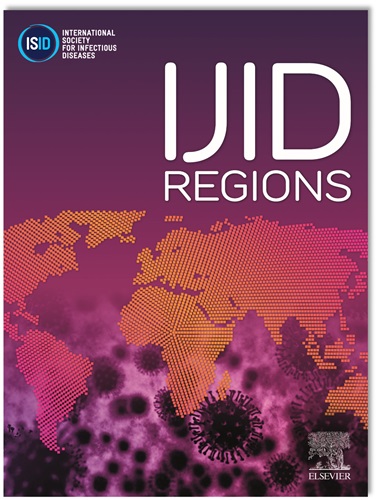Seroprevalence of dengue in the Democratic Republic of Congo, Ghana and Senegal: results of the SERODEN study
IF 4.8
2区 医学
Q1 INFECTIOUS DISEASES
引用次数: 0
Abstract
Introduction
There are limited data on dengue transmission across most of African countries, including Senegal, Ghana, and the Democratic Republic of the Congo (DRC). We aimed to assess the age-stratified dengue seroprevalence and estimate the force of infection (FOI, per-capita risk of dengue infection for a susceptible subject) in these countries.
Methods
We surveyed 14 regions in Senegal, 3 cities in Ghana, and 2 cities in DRC, leveraging blood samples collected from previous SARS-CoV-2 serosurveys of individuals aged 0 to 94 years. An Enzyme-Linked Immunosorbent Assay (ELISA) was used to measure IgG antibody levels against purified dengue particles (ELISA-1). A subset of samples was tested by ELISA for IgG against the recombinant nonstructural protein (NS1) of dengue (ELISA-2) and using a Plaque Reduction Neutralization Test (PRNT) for all four dengue serotypes.
We used a Bayesian approach to reconstruct results obtained in the study and estimated the force of infection of dengue assuming a time-constant transmission.
Results
In total, 8203 samples were tested by IgG ELISA-1: 1486 in Ghana, 3137 in Senegal and 3580 in DRC. Based on the IgG ELISA results, there was significant heterogeneity in the annual per capita risk of dengue infection across regions of Senegal, ranging from 0.2% (95% CrI: 0.1-0.3%) in Dakar to 2.6% (95% CrI: 1.9 -3.6%) in Fatick, corresponding to overall seroprevalence estimates of 5% (95% CrI: 3-8%) and 39% (95% CrI: 32-47%), respectively. In DRC, the average yearly FOI obtained from the IgG ELISA-1 results was 2.9% (95% CrI: 2.2-3.9%) in Kinshasa and 1.4% (95% CrI: 0.9-2.0%) in Matadi, with an overall population seroprevalence of 41% (95% CrI: 34-48%) in Kinshasa and 23% (95% CrI: 17, 32%) in Matadi. There were large heterogeneities in dengue transmission intensity across locations in Ghana, with a higher average yearly FOI in Tamale at 7.1% (95% CrI 5.6-9.6%)] compared to Accra at 2.6% (95% CrI 2.1-3.3%) and Kumasi at 0.5% (95% CrI 0.1-0.8%). Based on these results, we estimated that 43%, 11%, and 70% of the Accra, Kumasi, and Tamale populations, respectively, had been exposed to dengue virus. Notably, we found that the integration of the IgG ELISA-2 and PRNT test generated consistent estimates to those obtained with the IgG ELISA-1 test across locations.
Conclusion
This three-country seroprevalence study provides evidence that dengue has been circulating at different levels across Ghana, DRC, and Senegal and highlights the large heterogeneity in population immunity and transmission across regions. Dengue surveillance needs to be strengthened in these countries and across Africa to monitor transmission and respond to future outbreaks.
求助全文
约1分钟内获得全文
求助全文
来源期刊
CiteScore
18.90
自引率
2.40%
发文量
1020
审稿时长
30 days
期刊介绍:
International Journal of Infectious Diseases (IJID)
Publisher: International Society for Infectious Diseases
Publication Frequency: Monthly
Type: Peer-reviewed, Open Access
Scope:
Publishes original clinical and laboratory-based research.
Reports clinical trials, reviews, and some case reports.
Focuses on epidemiology, clinical diagnosis, treatment, and control of infectious diseases.
Emphasizes diseases common in under-resourced countries.

 求助内容:
求助内容: 应助结果提醒方式:
应助结果提醒方式:


